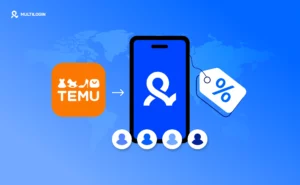Table of Contents
Digital Fingerprinting
In the early days of the internet, tracking was primarily done using cookies. Websites would store small pieces of data on a user’s device to remember preferences and track behavior, as online advertising became more advanced, there was a growing need for more reliable tracking systems.
Today, we will be discussing how digital fingerprinting remains a widely used technique for device identification and tracking, particularly in the context of fraud prevention, security, and advertising.
What is Digital Fingerprinting?
Digital fingerprinting refers to the process of creating unique identifiers from digital content to track, identify, and verify data or the device that created it. It serves various purposes such as copyright protection, security, and fraud detection.
This fingerprint is like a digital version of a human fingerprint, it can be used to recognize and track digital items. These fingerprints can come from several types of digital content like audio, video, images, software, and hardware.
Are Cookie Tracking and Digital Fingerprinting the Same Thing?
They are related but not the same, hence they operate differently. Cookies are small pieces of data saved on a user’s device by websites they visit.
Additionally, they are primarily used to remember user preferences, their login sessions, and other browsing information.
Digital fingerprinting is used for tracking and identifying users across different websites and sessions, even if cookies are disabled or deleted.
Here are few differences:
- Cookie tracking – Are small text files stored on the user’s device by the web browser. The website sets cookies to save user preferences, login information and track browsing behavior. Cookies can be deleted or blocked, which stops tracking. It is commonly used to keep users logged in, language preferences, and advertising.
- Digital fingerprinting – No data is stored on the user’s device with digital fingerprinting. Instead, information is collected from the device’s operating system, browser type, installed fonts, screen resolution, and more to create a unique identifier. It is difficult to evade tracking by deleting files.
How to Get Digital Fingerprints
Here’s a step-by-step explanation of how digital fingerprints are typically obtained:
- Collect device information – Identify the type and version of the operating system, detect the browser being used, gather information on installed browser plugins and extensions and then check the screen resolution and color depth settings of the device.
- Collect browser information – Capture HTTP headers sent by the browser, which may include information about language settings, encoding, then analyze the user agent string, which provides details about the browser and operating system, also detect the device’s time zone settings, and identify the language and regional settings of the browser.
- Collect hardware information – Determine the type and capabilities of the device’s CPU and GPU, also check the available device memory and storage capacity, and detect the status of the battery and health if applicable.
- Behavioral and interaction data – Track patterns in mouse movements and keystrokes but for touch devices, analyze touchscreen interaction patterns.
- Generate a unique identifier – Combine the collected data points into a single dataset and use a hashing algorithm to create a unique identifier or “fingerprint”. This hash is unique to the specific combination of characteristics collected.
What is Digital Watermarking and Fingerprinting?
Both digital watermarking and fingerprinting are valuable technologies for managing and protecting digital content and devices but are totally different with almost the same goals.
Watermarking is primarily focused on attaching additional information for protection and verification, while fingerprinting involves creating unique identifiers from inherent characteristics for tracking and authentication purposes.
Differences Between Digital Watermarking and Fingerprinting
- Watermarking embeds additional information into the content while fingerprinting extracts inherent characteristics from the content or device.
- Watermark is sometimes hidden or visible while fingerprint is not added to the content but rather a unique identifier derived
- Watermarking is used for copyright protection, ownership verification, authentication, and tracing while fingerprinting is used for tracking, identification, fraud detection, and security application.
- Watermarking should remain intact through common alterations while fingerprinting, Identifier should be consistent even with slight modifications to the content or device.
Applications
Digital fingerprinting is applicable in various fields such as:
- Security and Fraud Detection – it helps in identifying and blocking unauthorized devices trying to access networks or services.
- Forensic Investigations – It is used to track cybercriminals, trace digital evidence, and ensure its authenticity.
- Advertising – Use in targeted advertising and user behavior tracking.
- Digital Rights Management – Role in protecting digital content and intellectual property.
- Biometric Authentication – integrating fingerprints as part of multi-factor authentication systems for enhanced security.
- Healthcare and Personalization – it is used to securely manage and access electronic health records (EHR) and providing tailored recommendations and services based on user preferences and history
- Copyright Protection and Content Management – it ensures that only authorized users can access and use digital content.
Key Takeaways
Digital fingerprinting is a vital technique used to identify devices or users based on their unique software and hardware configurations. It enhances security by protecting content, preventing abuse, and recognizing users to deliver better experiences and personalized ads.
Overall, digital fingerprinting is essential for maintaining integrity, authenticity, and confidentiality in digital environments, serving as a crucial tool for both security and compliance.
People Also Ask
Digital fingerprinting utilizes different technologies to create unique identifiers for digital content and devices. From using hash functions and cryptographic techniques to machine learning and behavioral analysis, these technologies work together to ensure accurate and reliable identification and tracking in various applications.
Digital watermarking and digital fingerprinting are essential tools in safeguarding intellectual property rights, thwarting unauthorized use and distribution of digital content, and bolstering content strategies across industries like media, entertainment, publishing, and software.
Related Topics

Bypassing Cloudflare and restoring access to websites in 2026
Website protection systems continue to evolve, and Cloudflare has become one

How to use Pinterest for marketing: mobile-first strategy powered by Android emulation
Why marketers now rely on Android-emulation to unlock mobile-only traffic, visibility,

Stop buying aged TikTok accounts: build safer long-term profiles with Multilogin
TikTok has turned into one of the most important platforms for

Temu coupon codes for existing users: how to unlock more mobile discounts with Multilogin
If you have been shopping on Temu for a while, you